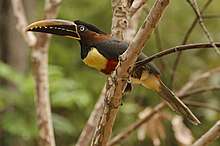Chestnut-eared aracari
| Chestnut-eared aracari | |
|---|---|
 | |
| in Chapada dos Veadeiros, Brazil | |
| Scientific classification | |
| Kingdom: | Animalia |
| Phylum: | Chordata |
| Class: | Aves |
| Order: | Piciformes |
| Family: | Ramphastidae |
| Genus: | Pteroglossus |
| Species: | P. castanotis |
| Binomial name | |
| Pteroglossus castanotis Gould, 1834 | |
| Subspecies | |
|
See text | |
The chestnut-eared aracari, or chestnut-eared araçari (Pteroglossus castanotis), is a bird native to central and south-eastern South America. It belongs to the toucan and aracari family (Ramphastidae). The chestnut-eared aracari is a larger, more colorful bird than the black-necked aracari, which it otherwise resembles.
Taxonomy and systematics
Subspecies

Two subspecies are recognized:[2]
Distribution and habitat
The range of the chestnut-eared aracari is the southern Amazon Basin, especially the southwestern of this region. It is also found in the eastern Andean foothills; a narrowing range extension enters central-southern Colombia by 900 kilometres (560 mi).
The southern Amazon Basin range narrows in the southeast to only the upstream half-headwaters of the north-flowing Amazon River tributaries. This range continues southeastwards into the central and southern cerrado and ends in the Paraná River region in eastern Paraguay, Bolivia, southeastern Brazil and the extreme northeast of Argentina.[3]
It is very present in Bolivia, notably in the Aquicuana Reserve, located in the Beni Department, near the city of Riberalta, the Capital of the Bolivian Amazon.
Behaviour and ecology
Food and feeding
Like others in the genus Pteroglossus, its diet mainly consists of fruit taken from trees in the area, sometimes retrieved by hanging upside-down. The chestnut-eared aracari also may include flower nectar, insects, and nuts in its diet as well.[4] Engaging in behavior similar to the saffron toucanet, they also appear to prey on the nests of other bird species, eating the eggs and baby birds.[5]
Threats
Ischnoceran lice found on the chestnut-eared aracari were first described as Austrophilopterus cancellosus castanotus, but these parasites are actually indistinguishable from those on most other Pteroglossus, and today are united with them in Austrophilopterus flavirostris.[6]
References
- ↑ BirdLife International (2012). "Pteroglossus castanotis". IUCN Red List of Threatened Species. Version 2013.2. International Union for Conservation of Nature. Retrieved 26 November 2013.
- ↑ "IOC World Bird List 6.4". IOC World Bird List Datasets. doi:10.14344/ioc.ml.6.4.
- ↑ Glayson Ariel Bencke (June 22, 2007). Avifauna atual do Rio Grande do Sul, Brasil: aspectos biogeográficos e distribucionais [The Recent avifauna of Rio Grande do Sul: Biogeographical and distributional aspects] (PDF). Quaternário do RS: integrando conhecimento. Canoas, Rio Grande do Sul, Brazil.
- ↑ "Chestnut-eared aracari : Dallas World Aquarium". www.dwazoo.com. Retrieved 2018-01-03.
- ↑ "Chestnut-eared Araçari". www.oiseaux-birds.com. Retrieved 2018-01-03.
- ↑ Roger D. Price & Jason D. Weckstein (2005). "The genus Austrophilopterus Ewing (Phthiraptera: Philopteridae) from toucans, toucanets, and araçaris (Piciformes: Ramphastidae)" (PDF excerpt). Zootaxa. 918: 1–18.
External links
- "Chestnut-eared aracari media". Internet Bird Collection.
- Chestnut-eared aracari photo gallery at VIREO (Drexel University)

